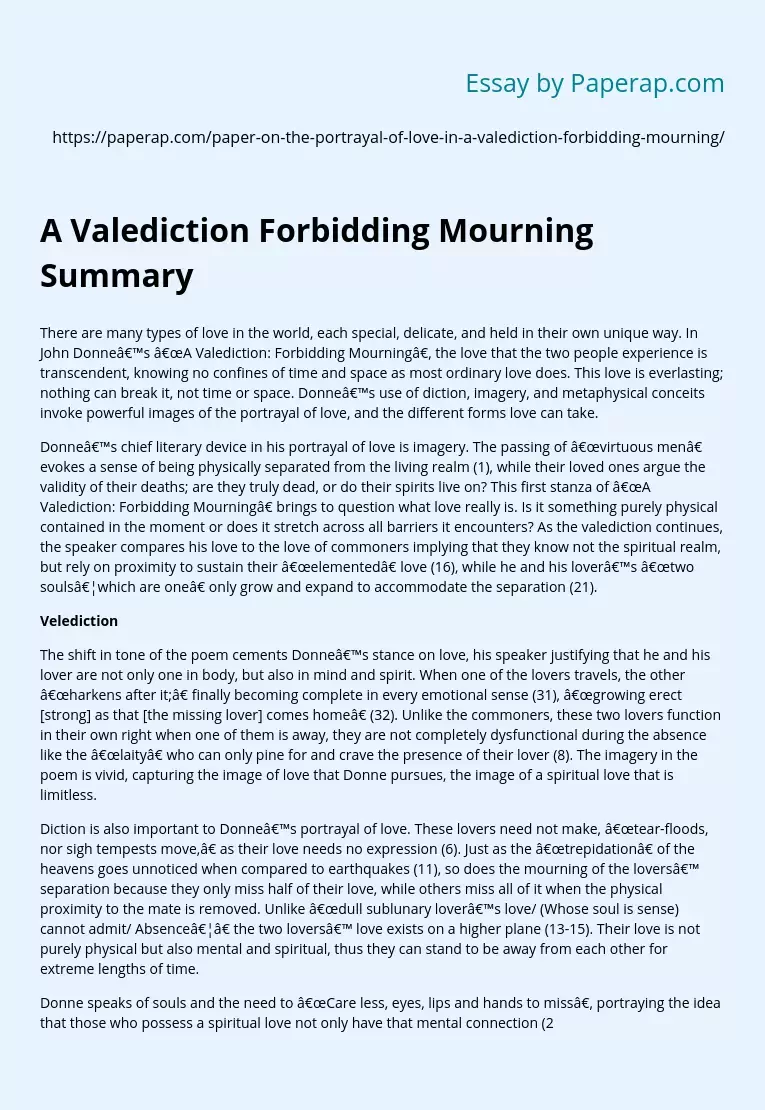A Valediction Forbidding Mourning Summary
There are many types of love in the world, each special, delicate, and held in their own unique way. In John Donne’s “A Valediction: Forbidding Mourning”, the love that the two people experience is transcendent, knowing no confines of time and space as most ordinary love does. This love is everlasting; nothing can break it, not time or space. Donne’s use of diction, imagery, and metaphysical conceits invoke powerful images of the portrayal of love, and the different forms love can take.
Donne’s chief literary device in his portrayal of love is imagery. The passing of “virtuous men” evokes a sense of being physically separated from the living realm (1), while their loved ones argue the validity of their deaths; are they truly dead, or do their spirits live on? This first stanza of “A Valediction: Forbidding Mourning” brings to question what love really is. Is it something purely physical contained in the moment or does it stretch across all barriers it encounters? As the valediction continues, the speaker compares his love to the love of commoners implying that they know not the spiritual realm, but rely on proximity to sustain their “elemented” love (16), while he and his lover’s “two souls…which are one” only grow and expand to accommodate the separation (21).
Velediction
The shift in tone of the poem cements Donne’s stance on love, his speaker justifying that he and his lover are not only one in body, but also in mind and spirit. When one of the lovers travels, the other “harkens after it;” finally becoming complete in every emotional sense (31), “growing erect [strong] as that [the missing lover] comes home” (32).
Unlike the commoners, these two lovers function in their own right when one of them is away, they are not completely dysfunctional during the absence like the “laity” who can only pine for and crave the presence of their lover (8). The imagery in the poem is vivid, capturing the image of love that Donne pursues, the image of a spiritual love that is limitless.
Diction is also important to Donne’s portrayal of love. These lovers need not make, “tear-floods, nor sigh tempests move,” as their love needs no expression (6). Just as the “trepidation” of the heavens goes unnoticed when compared to earthquakes (11), so does the mourning of the lovers’ separation because they only miss half of their love, while others miss all of it when the physical proximity to the mate is removed. Unlike “dull sublunary lover’s love/ (Whose soul is sense) cannot admit/ Absence…” the two lovers’ love exists on a higher plane (13-15). Their love is not purely physical but also mental and spiritual, thus they can stand to be away from each other for extreme lengths of time.
Donne speaks of souls and the need to “Care less, eyes, lips and hands to miss”, portraying the idea that those who possess a spiritual love not only have that mental connection (20), but also the physical connection that is never forgotten, although it does not take center stage to the mental aspect of their love like it does with the “laity” (8). Earthly and elemental diction is intertwined with spiritual connotations, the “trepidation of the heavens” contrasted with earthquakes and the delicate thinness of gold (11), suggesting that both being in balanced is the key to acquiring the superior love held by these two lovers in the poem.
The most important and descriptive combination of both of these literary devices culminate themselves in Donne’s use of metaphysical conceits, which are both used after the shift of tone in the poem. Donne’s speaker uses these particular conceits to explain why he and his lover are able to stay as one soul while they are apart. Donne employs the comparison of the “aery thinness” of the gold (24), much like a bridge joint expands and contracts, compensating for change while always remaining joined, to solidify that the speaker and his lover are firmly bound, never fully parting from each other. The image of the compass is also vivid, the lover’s “fixed foot, makes no show/ To move”, but does so in complete unison when the other end of the compass [the other lover] bids it to lean (27-28). The reference to the compass is very mechanical and even harsh, yet completely realistic because it is powerful in its image of connection. Nothing can break the “twin compasses” or the balance they possess (26).
Donne sees love as something to be cherished and conveys this through his speaker’s belief in love knowing no bounds, not even death. It is, however, ironic that he should choose to entitle the poem “A Valediction: Forbidding Mourning”, because a valediction is something that should not need to be voiced, much like the love that the speaker tells of. Donne sees love as something spiritual; nothing comes in its way, it cannot be maimed by absence nor can death kill it. Donne sees love as something that should be balanced and proportioned; neither aspect, the physical nor emotional, should have free reign over the other.
A Valediction Forbidding Mourning Summary. (2019, Dec 05). Retrieved from https://paperap.com/paper-on-the-portrayal-of-love-in-a-valediction-forbidding-mourning/

